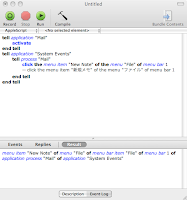

The passcode (password) of iPhone/iPod touch is just only four digit numbers.
I think it is not safe enough for our all-day-use information device.
Apple provides "iPhone and iPod touch Enterprise Deployment Guide" and "iPhone Configuration Utility", but I could not easily start with them.
A post at
Mac OS X Hints titled "
Use a longer alphanumeric passcode on the iPhone" provides very easy instruction.
You can let your iPhone/iPod touch to require six alpha-numeric password instead of four digits.
- Save the XML text of the post to a file with ".mobileconfig" extension.
- Create e-mail message, attach the file, and send it to your iPhone/iPod touch.
- With iPhone/iPod touch, open the message received, tap the attachment, and install it.
- Then the profile will be installed. You will be prompted the old password, and new password (more than six character, and alpha-numeric).
After successful, the Enter Passcode display is enhanced like the picture below.
The password security of iPhone/iPod touch is powered up.
If you want to restore the password to four digits, open [Setting] -> [General] -> [Profile] and [Remove].
[2009-06-19 #01 IMPORTANT NOTICE]
Please do NOT install "iPhone Configuration Utility 1.1" (dated 2008-12) on your Mac running iTunes 8.1/8.2.
If you do so, MobileDevice.framework will be degraded and you can not sync your iPhone/iPod touch with your iTunes ("symbol not found" error will be logged on system.log).
To resolve this problem, you should restore /System/Library/PrivateFrameworks/MobileDevice.framework from your TimeMachine, or delete it and re-install iTunes (I spent two nights for recovery).
[2009-06-19 #02]
Just after I wrote above notice, Apple released ICU 2.0 (2009-06).
I have not yet try it, but it may be better.
[
Japanese version]


 Follow the steps to make it.
Follow the steps to make it. Push [Run] button to test the script. You will see the Mail.app is open and new note window is appeared.
Push [Run] button to test the script. You will see the Mail.app is open and new note window is appeared. Then, do [File] -> [Save as], with "New Note" as file name, and specify [Application] for [File Format].
Then, do [File] -> [Save as], with "New Note" as file name, and specify [Application] for [File Format].


 The passcode (password) of iPhone/iPod touch is just only four digit numbers.
The passcode (password) of iPhone/iPod touch is just only four digit numbers.